Abstract
This study investigates the ability of water-soluble detergent capsules to effectively release microplastics from their composition. A total of 39 different brands of water-soluble capsulated detergents were tested, 20 of them for washing machines and 19 for dishwashers, from four different countries in the EU, i.e., Spain, Portugal, Belgium, and Italy, as well as two different devices for microplastic recovery from laundry wastewater. Wastewater samples from all laundry capsules reported microplastics, mainly as entangled fibers from PET blankets, although none could be associated to capsule itself. This paper displays, through a calculated rate for microplastics, that fiber shedding from clothing maybe related to different detergent characteristics. Wastewater from both catching devices reported microplastics after their use, although samples from Guppyfriend bag displayed less fibers than those collected after the use of Cora Ball. Eventually, wastewater samples form dishwashing detergent capsules were much less contaminated with microplastics than those from laundry ones.
1. Introduction
Microplastic (MP) has been defined as an emerging anthropogenic pollutant, with a general size smaller than 5 mm, except for fibers, for which a size of 15 mm is allowed []. The term was popularized in 2004, to describe microscopic plastics with a diameter under 20 µm [], and it is still under debate, as some authors have proposed the term “nanoplastics” for unintentionally produced particles within the size range from 1 to 1000 nm []. They are insoluble in water, with a low degradability, and belonging to a group of synthetic materials made up of polymers, generally derived from petroleum []. Microplastics can be divided into two well-differentiated groups: secondary microplastics, from the decomposition and fragmentation of macro and mesoplastics, and primary microplastics, also called microbeads, microspheres, or pellets, defined as intentionally manufactured microplastics widely used for different purposes in the polymer industry and in personal care products, abrasive blast cleaning or as vectors for drug transport, among many others []. Their abundance increases as fragment decreases, with a risk exacerbated for particles under 20 µm [].
Microplastics are recognized as one of the most important and continuously growing environmental problems, generating a large number of ecological impacts [,]. Once they are released into the environment, especially when they reach continental or oceanic waters, they can be ingested by plankton, fish, algae, mollusks, or small invertebrates, eventually reaching humans [,,]. Nowadays, they are considered a global threat to all ecosystems, not only due to the physical damage induced to the organisms that ingest them and leaching capacity of their components, but also as a potential carrier of organic and inorganic pollutants [,], with an interaction with living beings not yet sufficiently described.
WWTPs have been proved to be a pathway for MP to the environment, with release rates ranging from 0.93 × 10−6 MP/d [] to 1.4 × 108 MP/d [], and removal efficiencies that may reach 99% in some cases [], being highly efficient in retaining microplastics []. It is assessed that around 35% of microplastics in the ocean are fibers from synthetic textiles [], released from washing machines to wastewater treatment plants (WWTPs) [], especially during Autumn and Winter [,], and estimated over more than 1900 fibers per washing cycle and garment [], that for polyester fleece fabrics could reach 7360 fibers m−2·l−1 []. This could probably be due to an easy mechanism for fibers to longitudinally pass-through filters and membranes [,].
As far as we know, the effect of detergent, especially water-soluble capsulated detergents, has not been tested, neither for clothes nor dishwashers, with only a few studies dealing with washing machine conditions [,,]. Nowadays, this format is becoming much more common on marketed detergents, and due to its intense use, a significant amount of microplastics could be discharged through domestic wastewater pipes every day. As current wastewater treatment plants are not ready to remove these pollutants [], we could be introducing these invisible particles into water flows and, consequently, arriving coast ecosystems or soil, where this problem has been identified as an emergent problem and a priority for next years.
The aim of this study was to test whether detergents in water-soluble capsules were or not a source of microplastics in water flows and oceans. This research was carried out to check whether the wastewater of washing and dishwashing machines, with the use of detergents in capsules, discharges microplastics into nature and how important this issue could be.
2. Materials and Methods
2.1. Water-Soluble Detergents for Laundry and Dishwashing Machine
A total of 39 references of detergents marketed as hydro-soluble capsules were tested, 20 for washing machines and 19 for dishwashers, belonging to the trademarks and countries showed in Table 1.

Table 1.
Countries participating in the research, brands, and codes for water-soluble detergent capsules.
Besides the water-soluble detergent capsules tested, 10 different blank samples together with possible microplastic catching devices were analyzed, to check microplastics eliminated other than from detergent, as presented in Table 2.

Table 2.
Blank samples and microplastic catching devices analyzed during the study.
2.2. Washing Conditions
Wastewater samples from a washing machine and dishwasher were generated in a research centre devoted to conduct performance tests in detergents. This lab conducted different washing cycles in the same machine and washing conditions.
2.2.1. Laundry Washes
Laundry washes were carried out in a Miele washing machine W1935 model with a normal short cycle (1 h 49 min) at 30 °C (spinning 1200 rpm) and water hardness around 18 °F. The wastewater of the cycle was recovered in a stainless-steel tank and then homogenized before collecting 2 samples of 1 L. Each 1 L sample was vacuum filtered through a 110 mm paper filter using a Büchner funnel. The funnel wall was twice washed with deionized water, and also filtered. After that, filters were placed into 120 mm glass Petri dishes and evaporated to dryness in a forced air stove (Binder GmbH, Tuttlingen, Germany). All steps were carried out at room temperature (293 K). Finally, each filter containing sample was codified according to the previous lists with code numbers depicted in Table 1 and Table 2. Washing machines were rinsed out with a 60 °C washing cycle without detergent between different tests. Loadings were carried out with 3 blankets (100% polyester), twice washed at 40 °C with 70 g of ECE detergent before using, a standard detergent with a composition according to ISO 105-C08:2010. The blankets were dried before starting the tests and replaced for every single washing test.
2.2.2. Dishwashing
Dishwashing was carried out in a Bosch dishwashing machine (Super Silence Serie 4 model) with a normal cycle at 55 °C, ringing at 65 °C and 90 min, with a water hardness of 18 °F. Wastewater was collected in the same conditions as previously described for laundry cycles. Loadings were carried out with 6 wine glasses, 6 tumblers, 6 flat plates, 6 soup plates, 6 dessert plates, 6 coffee cups, 6 stainless steel knives, 6 stainless steel forks, 6 stainless steel tablespoons, 6 stainless steel dessert spoons, and 2 plastic boxes made of polypropylene. These boxes are common pieces of tableware used to house food at home.
2.3. Blank Samples and Microplastic Catching Devices
As depicted in Table 2, the blank samples comprised:
- Tap water, at the beginning (sample A—0001-00) and in the middle (sample B—0002-00) of the testing process, to check whether microplastic particles could come from the incoming water.
- Empty cycles, consisting of two wastewater samples, one from laundry (0003-00) and the other one from dishwashing (0004-00), without detergents nor textile garments or dishes, to check microplastics coming from machine devices.
- Two wastewater samples, one from laundry (0005-00) and the other one from dishwashing (0006-00), only with liquid detergent, to check whether the laundry/dishwashing detergents contributes to the release of microplastics.
- Two wastewater samples, one from laundry (0007-00) with only textile and the other one from dishwashing (0008-00) with only tableware, to check their contribution to microplastic release.
Besides these blank samples, two marketed devices that claim to “catch” microplastics from washing machine were tested: The Cora Ball (0009-00) and a bag for washing machines named Guppyfriend (0010-00).
2.4. Microplastic Identification
Once in our lab, filters with wastewater collected from the research centre were placed into 120 mm glass Petri dishes with 15 mL deionized water and agitated by orbital shaking (150 rpm, 30 min) to recover microplastics. After that, samples were dried overnight at 100 °C in a forced air stove FD 23 (Binder GmbH, Tuttlingen, Germany). All samples were analyzed in duplicate.
Possible microplastic (MP) particles were examined under an Olympus SZ-61TR Zoom Trinocular Microscope (Olympus Co., Tokyo, Japan) coupled to a Leica MC190 HD digital camera and an image capturing software Leica Application Suite (LAS) 4.8.0 (Leica Microsystems Ltd., Heerbrugg, Switzerland), used for the analysis and recording of color, shape, and size of each particle in its longest dimension. Once the images were captured, microparticles were successfully isolated in a 40 mm glass Petri dish for further analysis by Fourier transform infrared spectroscopy (FTIR).
FTIR was used for the identification of functional groups and molecular composition of polymeric surfaces. Samples were compressed in a diamond anvil compression cell, and spectra acquired with a Thermo Nicolet 5700 Fourier transformed infrared spectrometer (Thermo Nicolet Analytical Instruments, Madison, WI, USA), provided with a deuterated triglycine sulfate, DTGS, detector, and KBr optics. Spectra were collected at an average of 20 scans with a resolution of 16 cm−1 in the range of 400–4000 cm−1. They were controlled and evaluated by the OMNIC software without further manipulation, and polymers were identified by means of different reference polymer libraries, containing spectra of all common polymers, i.e., Hummel Polymer and Additives (2011 spectra), Polymer Additives and Plasticizers (1799 spectra), Sprouse Scientific Systems Polymers by ATR Library (500 spectra), and Rubber Compounding Materials (350 spectra), as indicated in literature []. The standard criteria regarding a >60% percentage match was applied [].
To reduce the risk of contamination, only clothes made of natural fabric and clean cotton lab coats were worn by the analysts. Enveloping material used for the sample transportation from the research centre was also analyzed, in order to check possible cross pollution. The use of plastic lab devices was limited to the maximum, although it could not be entirely avoided. All glassware was thoroughly washed with tap water and twice with deionized water after each experiment, covering it with aluminum foil to mitigate contamination. Statistical treatment of data was carried out with the SPSS 26.0 statistic software (IBM Co., Ltd., Armonk, NY, USA).
3. Results and Discussion
3.1. Enveloping Material, Blank Samples, Empty Cycles, and Catching Devices
In order to test a possible contamination of samples with plastic material used for the transportation of wastewater samples from the research centre to our lab, analysis of five different plastic polymers used in this process were analyzed by FTIR, as depicted in Figure 1. After FITR analysis, they proved to be: (1) Poly(t-butyl-acrylate) (match: 98.37%), (2) Polyethylene wax #2 (match: 87.64%), (3) Polyethylene (match: 88.52%), (4) Polypropylene, atactic (match: 97.90%), and (5) Poly(isobutene) (match: 83.11%).
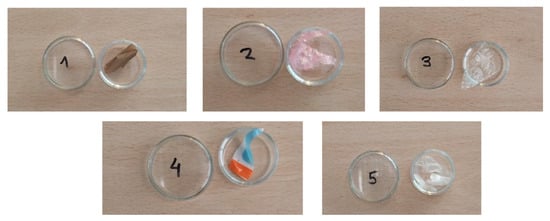
Figure 1.
Enveloping material used for sample transportation and analyzed by FTIR.
Only two microplastic particles in a fragmented form were isolated from tap water (0001-00), corresponding to high density polyethylene (HDPE) (Figure 2a) and polyvinyl chloride (PVC) (Figure 2b). Polyethylene is a common polymer, widely described as a constituent of microplastics in tap water [] and wastewater [,], being one of the polymer resins most demanded as a raw material by European plastic converters []. On the other hand, PVC is a common material mainly used for manufacturing pipes and flaked-off microplastics have been also detected in tap water, although always in a low concentration []. Sample 0002-00, also from tap water, displayed four isolated fibers, two of them depicted in Figure 2c,d.
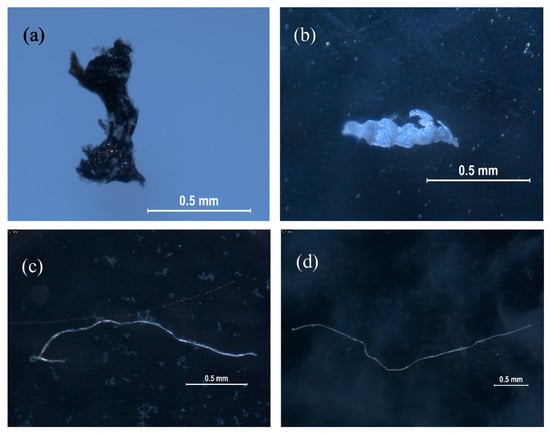
Figure 2.
Microplastics isolated in tap water: (a,b) 0001-00; (c,d) 0002-00.
Empty cycles, both from laundry (0003-00) and dishwashing (0004-00), also reported microplastics. A total of three fibers and a group of them were detected in all samples, as shown in Figure 3. The extremely small sizes and light colors, together with the possibility of plastic pigments and additives in their composition, gave a low percentage match in FTIR signal of three of them (Figure 3b,d); meanwhile the group of fibers (Figure 3a) was identified as polyethylene terephthalate (PET). These fiber debris should be considered as a remain from previous washing processes that still may remain in the pipes or in the washing device. Because fibers from wastewater collected from laundry presented as a knotty mass, it was not possible to efficiently count them. This fact has been already described by [] in wastewater samples from washing machines.
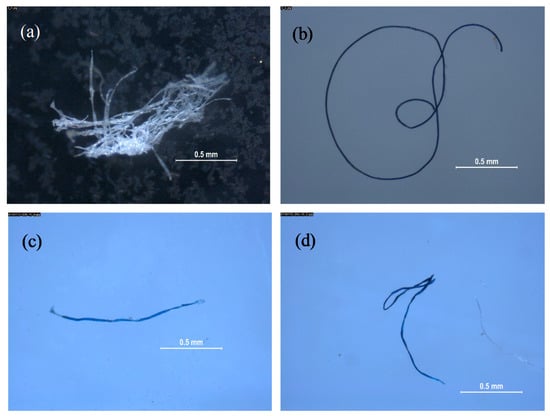
Figure 3.
Fibers isolated in: (a,b) empty laundry (0003-00), (c,d) empty dishwasher (0004-00).
Wastewater samples with only liquid detergent both from laundry (0005-00) and dishwashing (0006-00) also proved to display microplastics in its composition, as presented in Figure 4. Five different groups of fibers were isolated in wastewater samples from laundry only with liquid detergent, and only one from dishwashing wastewater, all of them proving to be PET fibers. As we have already discussed, an accurate count of fibers has proven to be difficult, because they often present in knotty masses []. However, although that statement proved to be clear for fibers coming from laundry wastewater (Figure 4a–c), separate fibers were present in dishwashing wastewater (Figure 4d).
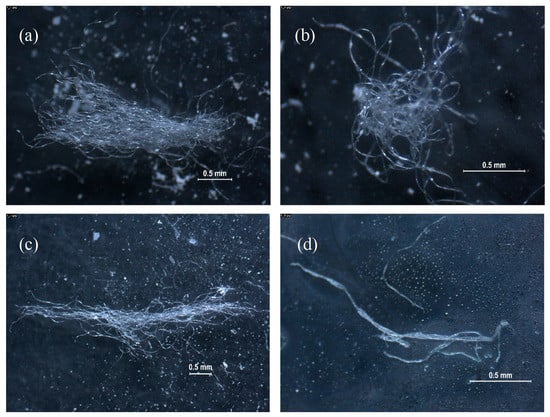
Figure 4.
Examples of PET fibers isolated in: (a–c) knotty masses from laundry wastewater with liquid detergent (0005-00), (d) dishwashing wastewater with liquid detergent (0006-00).
Wastewater samples from laundry with only 100% polyester blankets (0007-00) and from dishwashing with only tableware (0008-00), also displayed fibers in their composition, as depicted in Figure 5. A total of six groups of PET fibers were recovered from laundry with blankets, three of them depicted in Figure 5a–c, and only one fiber from tableware (Figure 5d).
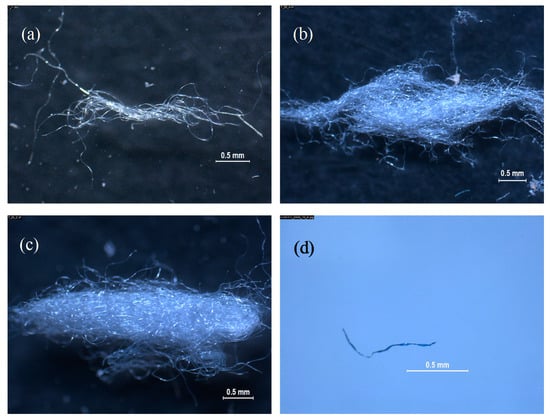
Figure 5.
Examples of PET fibers isolated in: (a–c) knotty masses from laundry wastewater with blankets (0007-00), (d) dishwashing wastewater with tableware (0008-00).
Finally, the efficiency for catching microplastics was tested by means of Cora Ball (0009-00) and the washing bag called Guppyfriend (0010-00), as previously indicated. These devices act as a microfiber filter between the synthetic clothing and the drain [,]. Both devices reported fibers after their use, although wastewater samples after the Guppyfriend bag displayed less fibers than wastewater samples after the use of Cora Ball. As depicted in Figure 6a,b, after the use of Cora Ball, fibers presented a tangled aspect, close to those fibers previously identified in wastewater samples with textile and constituted by PET. However, fibers collected after the use of Guppyfriend bag and shown in Figure 6c,d, were isolated as a single item, similar to those picked up from dishwashing wastewater, that were not confirmed as PET fibers. Similar results were reported by [] in the reduction of microfibers with the Cora Ball compared to the control.

Figure 6.
Isolated fibers: (a,b) knotty masses from wastewater with Cora-Ball (PET) (0009-00), (c,d) wastewater with Guppyfriend (0010-00).
As presented in Figure 6, skein-like fibers shown in pictures a and b should be from blanket washing, as they look like those reported in Figure 5a–c; meanwhile, fibers isolated from Guppyfriend (Figure 6c,d) could represent some cross pollution or stray fibers from polyester blankets after the washing process. As reported by [], not many fibers are present as stray fibers after a washing process. The fiber staple length and/or debris encapsulated inside the fabric from the yarn spinning could be directly responsible for releasing stray fibers [].
Because of the difficulty of counting groups of fibers, as previously indicated, and in order to compare results from different wastewaters from laundry and dishwashing samples, an artificial rate was calculated to standardize results from fiber images picked up by stereomicroscope. For that purpose, tangled fibers were categorized and further classified in a similar quantification way as reported by []. Groups of fibers were sized under the stereomicroscope (length x width) and classified according to the following scale from 1 to 10, where: 1 ≤ 0.5 mm2; 2 = 0.5–1 mm2; 3 = 1–1.5 mm2; 4 = 1.5–2 mm2; 5 = 2–2.5 mm2; 6 = 2.5–3 mm2; 7 = 3–3.5 mm2; 8 = 3.5–4 mm2; 9 = 4–4.5 mm2; 10 = 4.5–10 mm2, and 11 ≥ 10 mm2. The sum of all scaled groups of fibers gave a standardized figure for each water-soluble capsule type, in an artificial parameter used for calculations and named as calculated rate (CR). Table 3 shows the CR parameters for blank samples, empty cycles, and catching devices, considering a CR = 1 for each particulate MP. They were also sub-classified into three groups (tertiles) according to their position, as follows: T1 = first tertile (CR = 0–22) (green); T2 = second tertile (CR = 23–44) (orange), and T3 = third tertile (CR = 45–66) (red).

Table 3.
Calculated rate (CR) parameter for blank samples, empty cycles, and catching devices.
3.2. Microplastics in Water-Soluble Detergent Capsules
3.2.1. Laundry Capsules
A total of 20 water-soluble capsules for washing machine from different brands were analyzed, all of them presenting microplastics in their wastewater, except for sample 0018-00. The vast majority of them were tangled fibers from PET blankets, as previously indicated, and only three particulate microplastics were isolated, i.e., a fragment of high-density polyethylene (HDPE) in sample 0026-00, a fragment of polyvinyl chloride (PVC) in sample 0028-00, and a teflon film in sample 0038-00, as depicted in Figure 7.
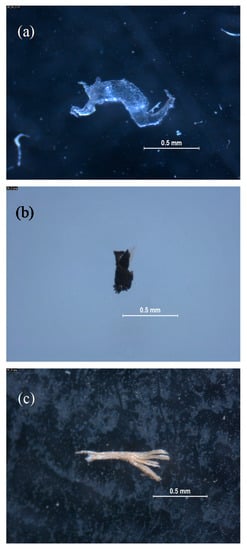
Figure 7.
Microplastics isolated in wastewater samples from laundry: (a) HDPE (0026-00), (b) PVC (0028-00), (c) TEFLON (0038-00).
The CR parameter proved to range from 0 for wastewater sample 0018-00 up to 66 for wastewater sample 0017-00. Table 4 shows the CR parameter for all laundry water-soluble detergents tested.

Table 4.
Calculated rate (CR) parameter for laundry water-soluble capsules.
As proposed by [], among all the variables tested in the propensity of fiber shedding in a mechanistic way, detergent appeared to affect the total mass of fibers released the most, although the detergent composition, liquid or powder, or overdosing of detergent did not significantly influence microplastic release. However, these authors did not test water-soluble capsules.
In our study, wastewater originated by the same brand model in different countries or formats did not always carry through the same behavior. For instance, wastewater from samples 0034-00 and 0048-00, the same commercial brand, although the first one from Belgium and the other one from Italy, displayed different CR parameters, i.e., 4 and 17, respectively. The same result occurred with samples 0036-00 (Belgium) and 0044-00 (Italy), with CR parameters of 22 and 38, respectively, and with samples 0015-00 (Spain) and 0025-00 (Portugal), with CR values of 61 and 41, respectively. The variability in duplicate experiments for the same brand was not predictable. In some instances, there was a very small deviation and others showed rather different fibers released. The same results were reported by [], even with triplicate variations, concluding that these fluctuations did not appear to be influenced by the fabric knit or the wash solution but some implicit variance in the washing from an unidentified source [].
Finally, when brand models were divided into three groups (tertiles), 14 brand models remained in the first tertile (70%), indicating a minimum amount of fiber shedding, while 4 brands stayed at T2 and only 2 brands at T3.
Figure 8 shows some examples of entangled PET fibers collected from wastewater samples from water-soluble detergents for laundry, with a typical FTIR transmittance spectrum acquired from 400–4000 cm−1 for wastewater sample 0017-00 (red line) and standard PET spectrum (black line). The absorption bands for PET at 3100–3400 cm−1 correspond to aromatic C-H stretch, 1730 cm−1 identifies the carbonyl group (C=O), 1300–1600 cm−1 the aromatic ring, and 1027 cm−1 the C-H in plane stretch [,,].
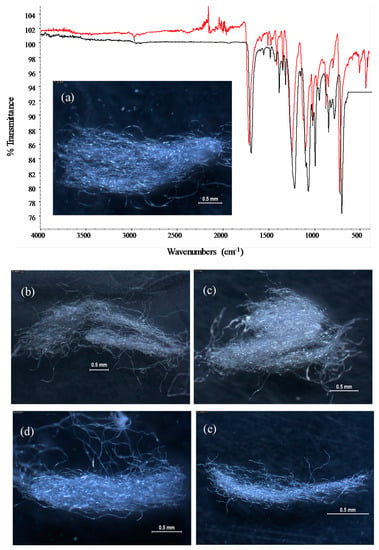
Figure 8.
Examples of entangled PET fibers collected from laundry water-soluble detergents wastewater: (a) FTIR spectrum for wastewater sample 0017-00 (red line) and standard PET spectrum (black line) (match: 90.37%) (Sprouse Scientific Systems Polymers by ATR); (b) 0028-00; (c) 0037-00; (d) 0026-00; (e) 0047-00.
3.2.2. Dishwashing Capsules
A total of 19 water-soluble capsules for dishwasher from different brands were investigated with regard to their wastewater, as proposed in the Materials and Methods previously described. In this sense, we found no indications that these samples were significantly contaminated with microplastic particles, as we will further discuss. Analysis through the stereomicroscope and FTIR displayed a vast majority of fiber form, although, unlike what we have reported for laundry wastewater samples, most of them were stray fibers (Figure 9).
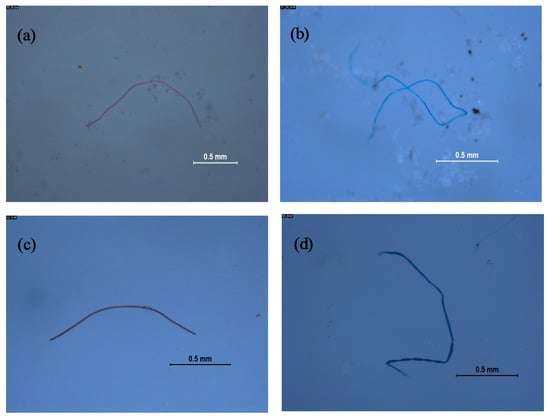
Figure 9.
Isolated fibers collected from dishwashing wastewater samples: (a) 0032-00; (b) 0021-00; (c) 0052-00; (d) 0053-00.
Most of these detected colored fibers were identified as cellulose-based materials, although some of them could not be identified or with a low percentage match for FTIR because of their small size, representing an extrapolated count of 0.29 fiber per liter of analyzed wastewater. Fibers were also found in groups, but never so crowded as in laundry wastewater samples, most of them identified as cellulose or PET, and most likely of textile origin (Figure 10).
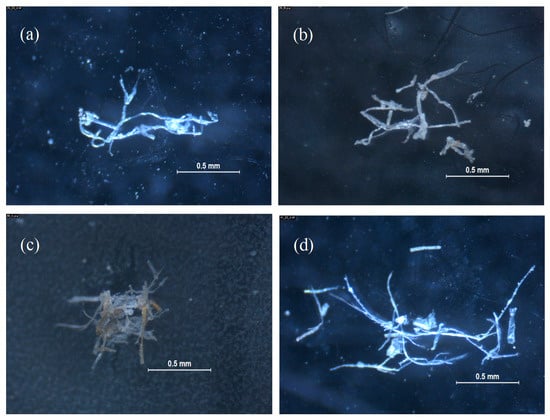
Figure 10.
Entangled fibers collected from dishwashing wastewater samples: (a) 0020-00; (b) 0029-00; (c) 0039-00; (d) 0041-00.
Fragmented microplastics were sporadically detected. In fact, only three fragments were present in three different wastewater samples, i.e., one polyurethane (PUR) particle from 0022-00, one polyvinylpyrrolidone (PVP) particle from 0033-00, and one polyacrylamide (PAAM) fragment from 0039-00, all of them depicted in Figure 11. Eventually, no cross contamination with PP microplastics from two plastic boxes used for dishwashing cycles was identified in any sample.
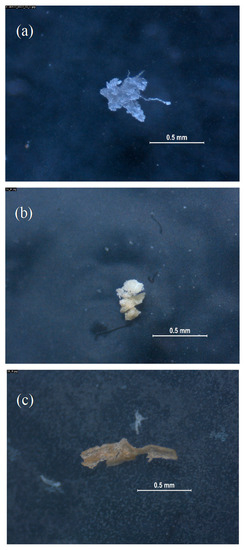
Figure 11.
Fragmented microplastics collected from dishwashing wastewater samples: (a) 0022-00 (Polyurethane-Hummel Polymer and Additives); (b) 0033-00 (Polyvinylpyrrolidone-Polymer Additives and Plasticizers); (c) 0039-00 (Polyacrylamide- Sprouse Scientific Systems Polymers by ATR Library).
Table 5 shows the CR parameter for all dishwashing water-soluble detergents tested, with all of them in the first tertile.

Table 5.
Calculated rate (CR) parameter for dishwashing water-soluble capsules.
The average amount of microplastic fragments did not represent more than 0.08 items per liter of analyzed wastewater. Microplastics from polyurethane (PUR) have been previously identified in samples from wastewater treatment plants [,], being the main constituent of blue polyurethane pipes []. PVP, also named polyvidone or povidone, is a water-soluble polymer, used as a food additive [], in contact lenses and their packaging solutions [], and as an excipient for pharmaceuticals with a certain inhibition on COVID-19 [], among other uses.
Both PUR and PVP are commonly produced in great amounts by industry, after polyethylene and polypropylene, with a density ranging from 1.16 to 1.56 g/mL []. On the other hand, the sporadic detected PAAM fragment (Figure 11c) could be related to tap water treatment, as PAAM is still used as a flocculant for drinking water purification [], or in many other uses, as a soil conditioner or in cement formulation []. Finally, some non-polymeric microparticles were also collected from dishwashing wastewater samples, including soap residues and their surfactants [], microscopic chipboard fragments, or polymer additives used as flame retardants. The identification of nanoplastics is significantly more challenging, and effective tools to image them should be used [], being a need to explore them into the global environment and effectively develop an integrative mass-balance model []. Future research efforts should be focused on standardized methodologies and reproducible analytical techniques for their count, classification, and characterization [].
4. Conclusions
This project evaluated the presence of microplastics in wastewater coming from the use of water-soluble detergent capsules, both for laundry and dishwashing, including a total of 39 different commercial brands from four countries, i.e., Spain, Portugal, Belgium, and Italy. The recovery experiment showed that the applied stereomicroscopic screening method, coupled to FTIR analysis, proved to be suitable for the identification of both fibers and microparticles isolated in filter surface. Even though most of samples investigated reported microparticles in their composition, we found no sign of significant pollution of wastewater samples with microplastics generated by capsules, or microplastics transferred directly from the water-soluble capsule composition. Our findings can be summarized as follows:
- A total of 103 samples were analyzed throughout the project, including 5 enveloping materials, 10 samples including blank samples, empty cycles and catching devices samples in duplicate, and 39 water-soluble capsules also analyzed in duplicate.
- Both devices tested for catching microplastics reported fibers in their composition, although wastewater from 0010-00 displayed less fibers than wastewater from 0009-00.
- The vast majority of fibers isolated from laundry wastewater samples were present as a knotty mass, difficult to efficiently be counted, meanwhile separate fibers were mostly present in dishwashing wastewater. In this sense, an artificial calculated rate (CR) was designed to standardize results from images picked up by stereomicroscope and their classification and quantification.
- The variability in duplicate experiments for the same commercial brand was not predictable, with some implicit variance from an unidentified source.
- A total of 70% of wastewater from water-soluble washing detergents reported a low CR parameter, in the first tertile, with only two brand models with a high fiber shedding from polyester blankets, i.e., 0015-00 and 0017-00.
- Wastewater samples from dishwashing water-soluble detergent capsules were much less contaminated with microplastics than those from laundry detergents.
- Detected microplastics in dishwashing wastewater included an extrapolated count of 0.29 fibers per liter, three fragmented microplastics, i.e., PUR, PVP, and PAAM, not representing more than 0.08 items per liter, and some non-polymeric microparticles.
Author Contributions
Conceptualization, J.B. and B.R.; Methodology, J.B., J.L.-C. and S.O.; Writing, J.B. and B.R.; Data acquisition, S.O., D.R. and J.L.-C.; Visualization, J.B. and B.R.; Funding acquisition, B.R. All authors have read and agreed to the published version of the manuscript.
Funding
This work was financed by Project 6212/20IQA (Consumers and Users Organization). This work is part of CLEAN Project funded by the Rights, Equality and Citizenship Programme of the European Commission (DG JUST) (Grant Agreement number 951671—CLEAN—REC-CONS-RPPI-AG-2019). Analyses carried out by Dr. Sonia Olmos were supported by a grant from Fundación Séneca (20268/FPI/17). The content of this publication represents the views of the authors only and their sole responsibility. The European Commission does not accept any responsibility for use that may be made of the information it contains.
Institutional Review Board Statement
Not applicable.
Informed Consent Statement
Not applicable.
Data Availability Statement
Data are contained within the article.
Acknowledgments
Authors gratefully acknowledge Altroconsumo and Test-Achats for their collaboration.
Conflicts of Interest
The authors declare no conflict of interest.
References
- European Chemicals Agency (ECHA). Annex XV Restriction Report Proposal for a Restriction; Report version number 1 (20 March 2019); European Chemicals Agency: Helsinki, Finland, 2019.
- Hartmann, N.B.; Huffer, T.; Thompson, R.C.; Hassellöv, M.; Verschoor, A.; Daugaard, A.E.; Rist, S.; Karlsson, T.; Brennholt, N.; Cole, M.; et al. Are we speaking the same language? Recommendations for a definition and categorization framework for plastic debris. Environ. Sci. Technol. 2019, 53, 1039–1047. [Google Scholar] [CrossRef] [PubMed] [Green Version]
- Gigault, J.; Ter Halle, A.; Baudrimont, M.; Pascal, P.Y.; Gauffre, F.; Phi, T.L.; Hadr, H.E.; Grassl, B.; Reynaud, S. Current opinion: What is a nanoplastic? Environ. Pollut. 2018, 235, 1030–1034. [Google Scholar] [CrossRef] [PubMed]
- Crawford, C.B.; Quinn, B. Microplastic Pollutants; Elsevier: Oxford, UK, 2017; 315p. [Google Scholar]
- Bayo, J.; Martínez, A.; Guillén, M.; Olmos, S.; Roca, M.J.; Alcolea, A. Microbeads in Commercial Facial Cleansers: Threatening the Environment. Clean-Soil Air Water 2017, 45, 1600683. [Google Scholar] [CrossRef]
- Hale, R.C.; Seeley, M.E.; La Guardia, M.J.; Mai, L.; Zeng, E.Y. A global perspective on microplastics. J. Geophys. Res. Oceans 2020, 125, e14719. [Google Scholar] [CrossRef]
- Gregory, M.R. Environmental implications of plastic debris in marine settings entanglement, ingestion, smothering, hangers-on, hitch-hiking and alien invasions. Philos. Trans. R. Soc. B 2009, 364, 2013–2025. [Google Scholar] [CrossRef]
- Bayo, J.; Rojo, D.; Olmos, S. Abundance, morphology and chemical composition of microplastics in sand and sediments from a protected coastal area: The Mar Menor lagoon (SE Spain). Environ. Pollut. 2019, 252, 1357–1366. [Google Scholar] [CrossRef]
- Cole, M.; Lindeque, P.; Halsband, C.; Galloway, T.S. Microplastics as contaminants in the marine environment: A review. Mar. Pollut. Bull. 2011, 62, 2588–2597. [Google Scholar] [CrossRef]
- Rochman, C.M.; Hoh, E.; Kurobe, T.; Teh, S.J. Ingested plastic transfers hazardous chemicals to fish and induces hepatic stress. Sci. Rep. 2013, 3, 3263. [Google Scholar] [CrossRef]
- Cox, K.D.; Covernton, G.A.; Davies, H.L.; Dower, J.F.; Juanes, F.; Dudas, S.E. Human consumption of microplastics. Environ. Sci. Technol. 2019, 53, 7068–7074. [Google Scholar] [CrossRef] [PubMed] [Green Version]
- Bakir, A.; Rowland, S.J.; Thompson, R.C. Competitive sorption of persistent organic pollutants onto microplastics in the marine environment. Mar. Pollut. Bull. 2012, 64, 2782–2789. [Google Scholar] [CrossRef] [PubMed]
- Carr, S.A.; Liu, J.; Tesoro, A.G. Transport and fate of microplastic particles in wastewater treatment plants. Water Res. 2016, 91, 174–182. [Google Scholar] [CrossRef] [PubMed]
- Talvitie, J.; Mikola, A.; Setälä, O.; Heinonen, M.; Koistinen, A. How well is microlitter purified from wastewater?—A detailed study on the stepwise removal of microlitter in a tertiary level wastewater treatment plant. Water Res. 2017, 109, 164–172. [Google Scholar] [CrossRef] [PubMed] [Green Version]
- Enfrin, M.; Dumée, L.F.; Lee, J. Nano/microplastics in water and wastewater treatment processes–origin, impact and potential solutions. Water Res. 2019, 161, 621–638. [Google Scholar] [CrossRef] [PubMed]
- Prata, J.C. Microplastics in wastewater: State of the knowledge on sources, fate and solutions. Mar. Pollut Bull. 2018, 129, 262–265. [Google Scholar] [CrossRef] [PubMed]
- Boucher, J.; Friot, D. Primary Microplastics in the Oceans: A Global Evaluation of Sources; International Union for Conservation of Nature: Gland, Switzerland, 2017; 43p. [Google Scholar]
- Bayo, J.; Olmos, S.; López-Castellanos, J. Microplastics in an urban wastewater treatment plant: The influence of physicochemical parameters and environmental factors. Chemosphere 2020, 238, 124593. [Google Scholar] [CrossRef]
- Browne, M.A.; Crump, P.; Niven, S.J.; Teuten, E.; Tonkin, A.; Galloway, T.; Thompson, R. Accumulation of microplastic on shorelines worldwide: Sources and sinks. Environ. Sci. Technol. 2011, 45, 9175–9179. [Google Scholar] [CrossRef]
- Bilgin, M.; Yurtsever, M.; Karadagli, F. Microplastic removal by aerated grit chambers versus settling tanks of a municipal wastewater treatment plant. J. Water Process. Eng. 2020, 38, 101604. [Google Scholar] [CrossRef]
- Almroth, B.M.C.; Åstrom, L.; Roslund, S.; Petersson, H.; Johansson, M.; Persson, N. Quantifying shedding of synthetic fibers from textiles; a source of microplastics released into the environment. Environ. Sci. Pollut. Res. 2018, 25, 1191–1199. [Google Scholar] [CrossRef] [Green Version]
- Bayo, J.; López-Castellanos, J.; Olmos, S. Membrane bioreactor and rapid sand filtration for the removal of microplastics in an urban wastewater treatment plant. Mar. Pollut. Bull. 2020, 156, 111211. [Google Scholar] [CrossRef]
- Sun, J.; Dai, X.; Wang, Q.; van Loosdrecht, M.C.; Ni, B.J. Microplastics in wastewater treatment plants: Detection, occurrence and removal. Water Res. 2019, 152, 21–37. [Google Scholar] [CrossRef]
- Napper, I.E.; Thompson, R.C. Release of synthetic microplastic plastic fibres from domestic washing machines: Effects of fabric type and washing conditions. Mar. Pollut. Bull. 2016, 112, 39–45. [Google Scholar] [CrossRef] [PubMed] [Green Version]
- De Falco, F.; Gullo, M.P.; Gentile, G.; Di Pace, E.; Cocca, M.; Gelabert, L.; Brouta-Agnésa, M.; Rovira, A.; Escudero, R.; Villalba, R.; et al. Evaluation of microplastic release caused by textile washing processes of synthetic fabrics. Environ. Pollut. 2018, 236, 916–925. [Google Scholar] [CrossRef] [PubMed]
- Fontana, G.D.; Mossotti, R.; Montarsolo, A. Assessment of microplastics release from polyester fabrics: The impact of different washing conditions. Environ. Pollut. 2020, 264, 113960. [Google Scholar] [CrossRef] [PubMed]
- Hummel, D.O. Atlas of Plastics Additives: Analysis by Spectrometric Methods; Springer: Berlin/Heidelberg, Germany, 2002; 537p. [Google Scholar]
- Frias, J.P.G.L.; Gago, J.; Otero, V.; Sobral, P. Microplastics in coastal sediments from Southern Portuguese shelf waters. Mar. Environ. Res. 2016, 114, 24–30. [Google Scholar] [CrossRef] [PubMed]
- Tong, H.; Jiang, Q.; Hu, X.; Zhong, X. Occurrence and identification of microplastics in tap water from China. Chemosphere 2020, 252, 126493. [Google Scholar] [CrossRef] [PubMed]
- Plastics Europe. Plastics—The Facts. An Analysis of European Plastics Production, Demand and Waste Data; Plastics Europe: Brussels, Belgium, 2020. [Google Scholar]
- Kniggendorf, A.K.; Wetzel, C.; Roth, B. Microplastics detection in streaming tap water with Raman spectroscopy. Sensors 2019, 19, 1839. [Google Scholar] [CrossRef] [PubMed] [Green Version]
- Estahbanati, S.; Fahrenfeld, N.L. Influence of wastewater treatment plant discharges on microplastic concentrations in surface water. Chemosphere 2016, 162, 277–284. [Google Scholar] [CrossRef]
- Lv, X.; Dong, Q.; Zuo, Z.; Liu, Y.; Huang, X.; Wu, W.M. Microplastics in a municipal wastewater treatment plant: Fate, dynamic distribution, removal efficiencies, and control strategies. J. Clean. Prod. 2019, 225, 579–586. [Google Scholar] [CrossRef]
- Okoffo, E.D.; O’Brien, S.; O’Brien, J.W.; Tscharke, B.J.; Thomas, K.V. Wastewater treatment plants as a source of plastics in the environment: A review of occurrence, methods for identification, quantification and fate. Environ Sci Water Res. 2019, 5, 1908–1931. [Google Scholar] [CrossRef]
- McIlwraith, H.K.; Lin, J.; Erdle, L.M.; Mallos, N.; Diamond, M.L.; Rochman, C.M. Capturing microfibers–marketed technologies reduce microfiber emissions from washing machines. Mar. Pollut. Bull. 2019, 139, 40–45. [Google Scholar] [CrossRef]
- Hernandez, E.; Nowack, B.; Mitrano, D.M. Polyester textiles as a source of microplastics from households: A mechanistic study to understand microfiber release during washing. Environ. Sci. Technol. 2017, 51, 7036–7046. [Google Scholar] [CrossRef] [PubMed]
- Chen, Z.; Hay, J.N.; Jenkins, M.J. FTIR spectroscopic analysis of poly (ethylene terephthalate) on crystallization. Eur. Polym. J. 2012, 48, 1586–1610. [Google Scholar] [CrossRef]
- Cincinelli, A.; Scopetani, C.; Chelazzi, D.; Lombardini, E.; Martellini, T.; Katsoyiannis, A.; Fossi, M.C.; Corsolini, S. Microplastic in the surface waters of the Ross Sea (Antarctica): Occurrence, distribution and characterization by FTIR. Chemosphere 2017, 175, 391–400. [Google Scholar] [CrossRef] [PubMed]
- Cao, Y.; Wang, Q.; Ruan, Y.; Wu, R.; Chen, L.; Zhang, K.; Lam, P.K. Intra-day microplastic variations in wastewater: A case study of a sewage treatment plant in Hong Kong. Mar. Pollut. Bull. 2020, 160, 111535. [Google Scholar] [CrossRef] [PubMed]
- Nguyen, T.H.; Tang, F.H.; Maggi, F. Sinking of microbial-associated microplastics in natural waters. PLoS ONE 2020, 15, e0228209. [Google Scholar] [CrossRef] [PubMed]
- EFSA Panel on Food Additives and Nutrient Sources added to Food (ANS). Scientific Opinion on the safety of polyvinylpyrrolidone-vinyl acetate copolymer for the proposed uses as a food additive. EFSA J. 2010, 8, 1948. [Google Scholar]
- Schafer, J.; Reindel, W.; Steffen, R.; Mosehauer, G.; Chinn, J. Use of a novel extended blink test to evaluate the performance of two polyvinylpyrrolidone-containing, silicone hydrogel contact lenses. Clin. Ophthalmol. 2018, 12, 819–825. [Google Scholar] [CrossRef] [Green Version]
- Kurakula, M.; Rao, G.K. Pharmaceutical assessment of polyvinylpyrrolidone PVP) as excipient from conventional to controlled delivery systems with a spotlight on COVID-19 inhibition. J. Drug Deliv. Sci. Technol. 2020, 60, 102046. [Google Scholar] [CrossRef]
- Xiong, B.; Loss, R.D.; Shields, D.; Pawlik, T.; Hochreiter, R.; Zydney, A.L.; Kumar, M. Polyacrylamide degradation and its implications in environmental systems. NPJ Clean Water 2018, 1, 17. [Google Scholar] [CrossRef]
- Liu, H.; Bu, Y.; Sanjayan, J.G.; Nazari, A.; Shen, Z. Suitability of polyacrylamide superabsorbent polymers as the internal curing agent of well cement. Constr. Build. Mater. 2016, 112, 253–260. [Google Scholar] [CrossRef]
- Kwaśniewska, D.; Wieczorek, D.; Staszak, K. Effect of amphoteric surfactants on surface and wetting properties of hand dishwashing liquids. Pol. J. Cosmet. 2019, 22, 301–304. [Google Scholar]
- Nigamatzyanova, L.; Fakhrullin, R. Dark-field hyperspectral microscopy for label-free microplastics and nanoplastics detection and identification in vivo: A Caenorhabditis elegans study. Environ. Pollut. 2021, 271, 116337. [Google Scholar] [CrossRef] [PubMed]
- Boyle, K.; Örmeci, B. Microplastics and nanoplastics in the freshwater and terrestrial environment: A review. Water 2020, 12, 2633. [Google Scholar] [CrossRef]
- Ricciardi, M.; Pironti, C.; Motta, O.; Miele, Y.; Proto, A.; Montano, L. Microplastics in the Aquatic Environment: Occurrence, Persistence, Analysis, and Human Exposure. Water 2021, 13, 973. [Google Scholar] [CrossRef]
Publisher’s Note: MDPI stays neutral with regard to jurisdictional claims in published maps and institutional affiliations. |
© 2022 by the authors. Licensee MDPI, Basel, Switzerland. This article is an open access article distributed under the terms and conditions of the Creative Commons Attribution (CC BY) license (https://creativecommons.org/licenses/by/4.0/).